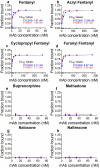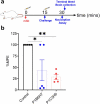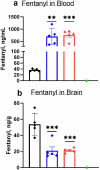Novel chimeric monoclonal antibodies that block fentanyl effects and alter fentanyl biodistribution in mice
- PMID: 34693882
- PMCID: PMC8547829
- DOI: 10.1080/19420862.2021.1991552
Novel chimeric monoclonal antibodies that block fentanyl effects and alter fentanyl biodistribution in mice
Abstract
The prevalence and societal impact of opioid use disorder (OUD) is an acknowledged public health crisis that is further aggravated by the current pandemic. One of the devastating consequences of OUD is opioid overdose deaths. While multiple medications are now available to treat OUD, given the prevalence and societal burden, additional well-tolerated and effective therapies are still needed. To this point, we have developed chimeric monoclonal antibodies (mAb) that will specifically complex with fentanyl and its analogs in the periphery, thereby preventing them from reaching the central nervous system. Additionally, mAb-based passive immunotherapy offers a high degree of specificity to drugs of abuse and does not interfere with an individual's ability to use any of the medications used to treat OUD. We hypothesized that sequestering fentanyl and its analogs in the periphery will mitigate their negative effects on the brain and peripheral organs. This study is the first report of chimeric mAb against fentanyl and its analogs. We have discovered, engineered the chimeric versions, and identified the selectivity of these antibodies, through in vitro characterization and in vivo animal challenge studies. Two mAb candidates with very high (0.1-1.3 nM) binding affinities to fentanyl and its analogs were found to be effective in engaging fentanyl in the periphery and blocking its effects in challenged animals. Results presented in this work constitute a major contribution in the field of novel therapeutics targeting OUD.
Keywords: Fentanyl mAb; fentanyl analogs; opioid use disorder; opioids; passive immunization.
Conflict of interest statement
This material has been reviewed by the Walter Reed Army Institute of Research, the National Institute on Drug Abuse, and Indiana Biosciences Research Institute. All animal studies were conducted under an approved animal use protocol in an Association for Assessment and Accreditation of Laboratory Animal Care International-accredited facility in compliance with the Animal Welfare Act and other federal statutes and regulations relating to animals. Experiments involving animals adhered to the principles stated in the Guide for the Care and Use of Laboratory Animals, 8th edition. There is no objection to its presentation and/or publication. The opinions or assertions contained herein are the private views of the authors, and should not be construed as official, or as reflecting true views of the Department of the Army, the Department of Defense, NIDA, NIH or the US government. GRM, AS, KCR, and AEJ are inventors of a provision patent application filed by the Henry M. Jackson Foundation for the Advancement of Military Medicine (provisional patent Serial No.: 62/960,187; January 13, 2020).
Figures






Similar articles
-
Development of fentanyl-specific monoclonal antibody (mAb) to antagonize the pharmacological effects of fentanyl.Toxicol Appl Pharmacol. 2024 May;486:116918. doi: 10.1016/j.taap.2024.116918. Epub 2024 Apr 1. Toxicol Appl Pharmacol. 2024. PMID: 38570042
-
Monoclonal Antibodies for Combating Synthetic Opioid Intoxication.J Am Chem Soc. 2019 Jul 3;141(26):10489-10503. doi: 10.1021/jacs.9b04872. Epub 2019 Jun 25. J Am Chem Soc. 2019. PMID: 31187995 Free PMC article.
-
Monoclonal Antibodies Counteract Opioid-Induced Behavioral and Toxic Effects in Mice and Rats.J Pharmacol Exp Ther. 2020 Dec;375(3):469-477. doi: 10.1124/jpet.120.000124. Epub 2020 Sep 26. J Pharmacol Exp Ther. 2020. PMID: 32980813 Free PMC article.
-
Unique Pharmacology, Brain Dysfunction, and Therapeutic Advancements for Fentanyl Misuse and Abuse.Neurosci Bull. 2022 Nov;38(11):1365-1382. doi: 10.1007/s12264-022-00872-3. Epub 2022 May 15. Neurosci Bull. 2022. PMID: 35570233 Free PMC article. Review.
-
Patent Review of Novel Biologics Targeting Opioid Use Disorder (2018-2024).ACS Chem Neurosci. 2024 Dec 18;15(24):4360-4368. doi: 10.1021/acschemneuro.4c00691. Epub 2024 Nov 28. ACS Chem Neurosci. 2024. PMID: 39606860 Review.
Cited by
-
Monoclonal Antibodies Engineered with Fc Region Mutations to Extend Protection against Fentanyl Toxicity.J Immunol. 2024 Sep 1;213(5):663-668. doi: 10.4049/jimmunol.2400170. J Immunol. 2024. PMID: 39018496 Free PMC article.
-
Fentanyl-Antibody Interaction as a Novel Strategy against Opiates and Opioids Abuse.J Med Chem. 2025 Apr 24;68(8):7866-7888. doi: 10.1021/acs.jmedchem.4c02860. Epub 2025 Apr 3. J Med Chem. 2025. PMID: 40178513 Free PMC article. Review.
-
An Engineered Human-Antibody Fragment with Fentanyl Pan-Specificity That Reverses Carfentanil-Induced Respiratory Depression.ACS Chem Neurosci. 2023 Aug 16;14(16):2849-2856. doi: 10.1021/acschemneuro.3c00455. Epub 2023 Aug 3. ACS Chem Neurosci. 2023. PMID: 37534714 Free PMC article.
-
Pharmacological Profiling of Antifentanyl Monoclonal Antibodies in Combination with Naloxone in Pre- and Postexposure Models of Fentanyl Toxicity.J Pharmacol Exp Ther. 2022 May;381(2):129-136. doi: 10.1124/jpet.121.001048. Epub 2022 Feb 13. J Pharmacol Exp Ther. 2022. PMID: 35153198 Free PMC article.
-
Advancing humanized monoclonal antibody for counteracting fentanyl toxicity towards clinical development.Hum Vaccin Immunother. 2022 Nov 30;18(6):2122507. doi: 10.1080/21645515.2022.2122507. Epub 2022 Oct 4. Hum Vaccin Immunother. 2022. PMID: 36194773 Free PMC article.
References
-
- National Vital Statistics System . 2019. Accessed: March 1, 2021. https://www.cdc.gov/nchs/nvss/index.htm
Publication types
MeSH terms
Substances
Grants and funding
LinkOut - more resources
Full Text Sources
Other Literature Sources
Medical
